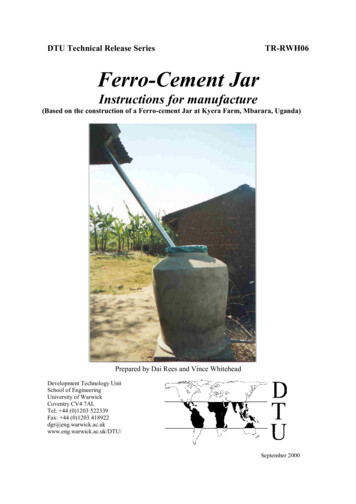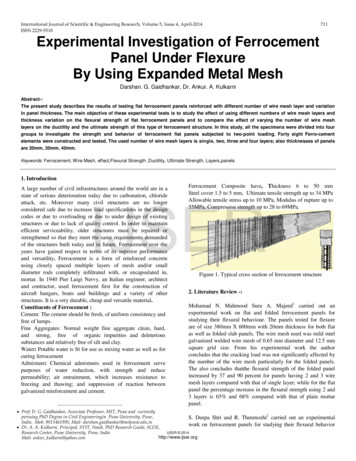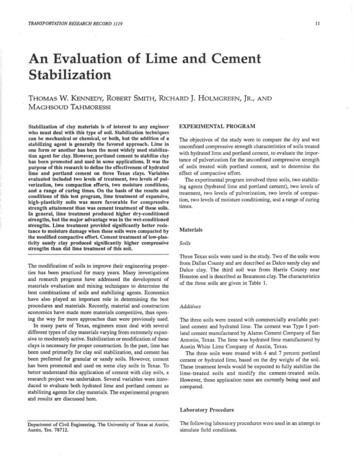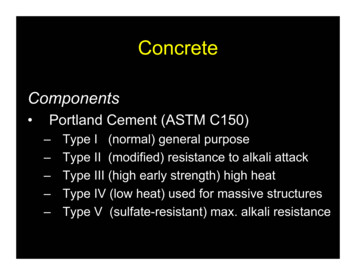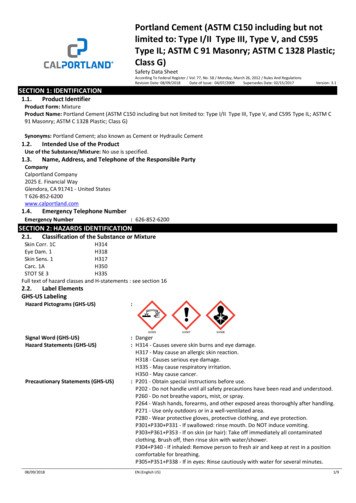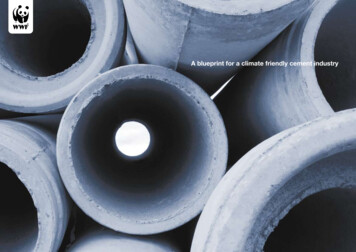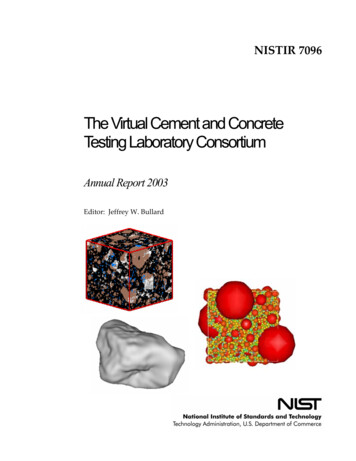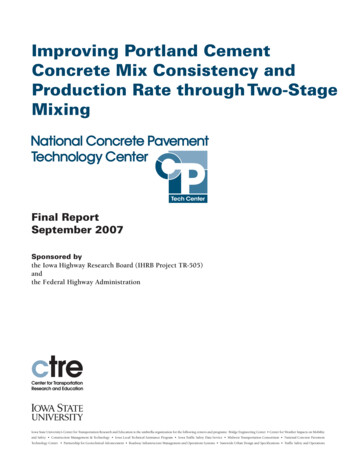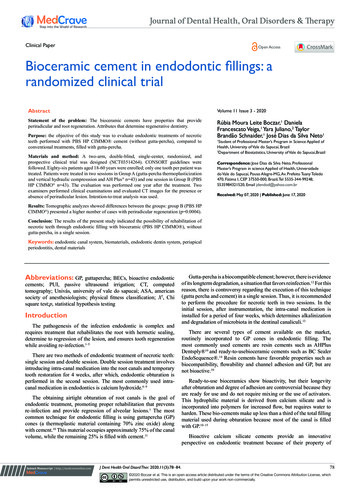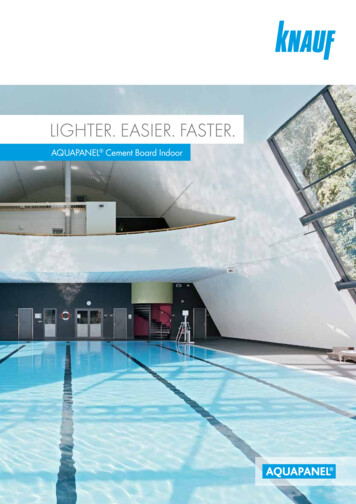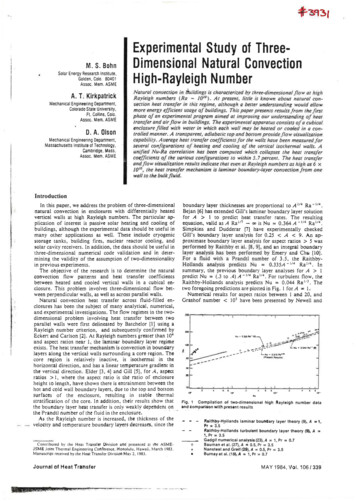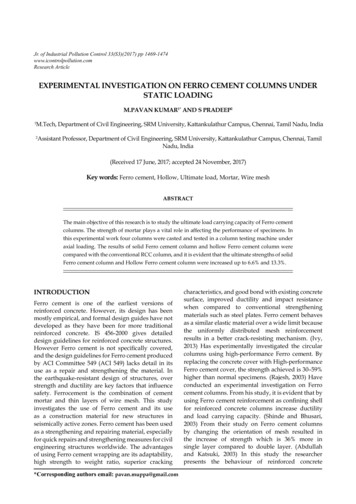
Transcription
Jr. of Industrial Pollution Control 33(S3)(2017) pp 1469-1474www.icontrolpollution.comResearch ArticleEXPERIMENTAL INVESTIGATION ON FERRO CEMENT COLUMNS UNDERSTATIC LOADINGM.PAVAN KUMAR1* AND S PRADEEP2M.Tech, Department of Civil Engineering, SRM University, Kattankulathur Campus, Chennai, Tamil Nadu, India1Assistant Professor, Department of Civil Engineering, SRM University, Kattankulathur Campus, Chennai, TamilNadu, India2(Received 17 June, 2017; accepted 24 November, 2017)Key words: Ferro cement, Hollow, Ultimate load, Mortar, Wire meshABSTRACTThe main objective of this research is to study the ultimate load carrying capacity of Ferro cementcolumns. The strength of mortar plays a vital role in affecting the performance of specimens. Inthis experimental work four columns were casted and tested in a column testing machine underaxial loading. The results of solid Ferro cement column and hollow Ferro cement column werecompared with the conventional RCC column, and it is evident that the ultimate strengths of solidFerro cement column and Hollow Ferro cement column were increased up to 6.6% and 13.3%.INTRODUCTIONFerro cement is one of the earliest versions ofreinforced concrete. However, its design has beenmostly empirical, and formal design guides have notdeveloped as they have been for more traditionalreinforced concrete. IS 456-2000 gives detaileddesign guidelines for reinforced concrete structures.However Ferro cement is not specifically covered,and the design guidelines for Ferro cement producedby ACI Committee 549 (ACI 549) lacks detail in itsuse as a repair and strengthening the material. Inthe earthquake-resistant design of structures, overstrength and ductility are key factors that influencesafety. Ferrocement is the combination of cementmortar and thin layers of wire mesh. This studyinvestigates the use of Ferro cement and its useas a construction material for new structures inseismically active zones. Ferro cement has been usedas a strengthening and repairing material, especiallyfor quick repairs and strengthening measures for civilengineering structures worldwide. The advantagesof using Ferro cement wrapping are its adaptability,high strength to weight ratio, superior cracking*Corresponding authors email: pavan.muppa@gmail.comcharacteristics, and good bond with existing concretesurface, improved ductility and impact resistancewhen compared to conventional strengtheningmaterials such as steel plates. Ferro cement behavesas a similar elastic material over a wide limit becausethe uniformly distributed mesh reinforcementresults in a better crack-resisting mechanism. (Ivy,2013) Has experimentally investigated the circularcolumns using high-performance Ferro cement. Byreplacing the concrete cover with High-performanceFerro cement cover, the strength achieved is 30–59%higher than normal specimens. (Rajesh, 2003) Haveconducted an experimental investigation on Ferrocement columns. From his study, it is evident that byusing Ferro cement reinforcement as confining shellfor reinforced concrete columns increase ductilityand load carrying capacity. (Shinde and Bhusari,2003) From their study on Ferro cement columnsby changing the orientation of mesh resulted inthe increase of strength which is 36% more insingle layer compared to double layer. (Abdullahand Katsuki, 2003) In this study the researcherpresents the behaviour of reinforced concrete
1470KUMAR ET AL.columns strengthened with Ferro cement jacketing.Ferro cement usedas a strengthening agent forconventional RC columns showed very good resultsin ductility and stable during plastic hinge formation.(Mourad and Shannag, 2012) In this investigationresearcher studied about repair and strengthening ofFerro cement jacketing to RC columns.Ferro cementjacketing to RC columns shows very good results incompressive strength and stiffness and it is about 28%33%. Similarly 15%-28% strength gained in repairingof RC columns with Ferro cement jacketing. (Yaqub,et al., 2013) Researcher conducted experimental studyon post heated circular and square columns repairedwith Ferro cement jacketing. By conducting variousexperiments optimal solution to regain the strengthof post heated columns is by providing both theFerro cement jacketing and fibre reinforced polymerswill show better results in ductility, compressivestrength, stiffness etc. (Rathish, et al., 2007) In thisstudy researcher presents the seismic loading testson RC and Ferro cement columns with jacketing.Energy dissipation capacity, ductility, stiffness hadincreased because of using Ferro cement as externalconfinement in columns. (Amrul, 2013; Mohammadand Reza, 2005) In this study by improving squareFerro cement jacketingthe ultimate load carryingcapacity of columns were increased and failure atcorners had minimised.EXPERIMENTAL PROGRAMMaterial properties and specificationsOrdinary Portland Cement (OPC) of 53 grade isusedfor test specimens for making both mortar andconcrete which is confining to IS 12269. Specificgravity of ordinary Portland cement is 3.15.Fineaggregate is commonly used in the matrix and coarseaggregate is used in preparing concrete. Specificgravity of fine and coarse aggregates are 2.64 and 2.7.Aggregates having high hardness, large strength andcontaining sharp silica can achieve the best strengthresults. However, the aggregate should be keptclean, inert, free of organic matter and deleterioussubstances and free of silt or clay. Additionally, (IS10262-2009) requires that 80%-100% of the weight ofthe aggregate should pass the IS Sieve No.7 (2.36 mm).The water used in Ferro cement should be fresh, cleanand free from organic or harmful solutions.Weldedwire mesh is used in this study which has a higherstiffness than woven mesh, which is why the weldedmesh leads to smaller deflections in the elastic stage.The galvanized iron weld mesh is shown in (Fig. 1)having a diameter of 1.26 mm and spacing of 15 mmcentre to centre. Welded mesh is more durable, moreintrinsically resistant to corrosion and more stable instructures than woven mesh (Bo, et al., 2013; Kaish,et al., 2012).Mix proportions and design specificationsIn this experimental study, M30 grade concrete mixis designed as per IS 10262-2009. 150 mm 150 mm 150 mm sized cubes were casted and tested to findthe compressive strength. Two trial mixes were doneto find the best grade of a matrix to cast Ferro cementcolumns. 70.6 70.6 70.6 mm sized cubes werecasted and tested to find the compressive strengthof matrix which is confining to IS 10080-1982. Thedetails of mix proportions are shown in Table 1.One square reinforced concrete column and threeFerro cement columns were casted. The detailing ofreinforcement in columns is shown in (Fig. 2), andit consisted of four longitudinal 8 mm ribbed steelbars and seven 6 mm steel bar stirrups, with 190 mmspacing in between. The prepared reinforcement cagewas held carefully in the moulds. Concrete spacers of20mm size were used to maintain 20 mm concretecover to the main reinforcement. One column hadtwo-layers of galvanized iron welded mesh, andtwo columns had one-layer of mesh. The dimensionsand skeleton of reinforcing mesh is shown in above(Fig. 1). One RCC column was casted and two Ferrocement solid columns, one Ferro cement hollowcolumn (Syal and Rejivsyal, 1997; American CementInstitute; IS 456:2000). A total of 4 specimens whichis having a dimension of 1000 mm height and aFig. 1 Welded mesh.Table 1. Details of mix proportions.FerroRCCcementSand/Cement ratio1:2 1:2.25 1:1.32:2.2Water/Cement ratio0.45 0.450.45Volume of cement (kg/m3)678 640492.5Volume of fine aggregate (kg/m3) 1357 1440651Volume of coarse aggregate1084(kg/m3)Volume of water (kg/m3)305 289197Variables
EXPERIMENTAL INVESTIGATION ON FERRO CEMENT COLUMNS UNDER STATICLOADING1471cross section of 110 110 mm were casted andtested as shown in (Fig. 3). These specimens aretested by using 500 kN hydraulic jack and provingring which is arranged in a column testing machine.Deflectometers are arranged in center of the columnon both sides of a specimen to find deflection. Thetesting frame is shown in (Fig. 4) (section along withthe specimen).RESULTS AND DISCUSSIONThe compressive strengths of concrete and mortarmix for 7, 14, 28 days are shown in (Fig. 5). Allcasted cubes of concrete and mortar are tested incompressive testing machine which has a capacity of200 ton as shown in (Fig. 6). Total of 27 cubes (9 cubesfor concrete and 18 cubes for mortar) were tested tofind the compressive strength.To find the best matrixtwo trial mixes were used. Concrete achieved astrength of 32.4 N/mm2 and mortar mix achieved acompressive strength of 37.4 N/mm2 after curing of28 days. Experimental results for cubes were shownbelow in Table 2.Fig. 4 Column test setupFig. 5 Compressive testing machine.Fig. 2 Detailing of reinforcement in columns.Fig. 3 Casted specimens.All the tested specimens with failure crack patternsare showed in (Fig. 7-9) respectively. Failure of Ferrocement hollow column is clearly shown in (Fig. 7)and the crack occurred at the top face of column,weld mesh buckles out. Similarly for conventionalcolumn the failure occurred at bottom face of columnand spalling of concrete occurred as shown in (Fig.8). Conventional column has achieved a compressivestrength of 232 KN with a deflection of 1.62 mm.Failure of Ferro cement solid columns takes placealong the periphery of specimen, diagonal crackswere observed and spalling of mortar takes placeinstead of buckling welded mesh are clearly shownin (Fig. 9). The collapse load thus determined for allcolumns were shown in Table 3. Load vs. deflectiongraphs were plotted for all the tested specimens areshown in (Fig. 10). Ferro cement hollow columncarries a load of 272 KN with a deflection of 2.86mm.By increasing number of layers of weld wire meshcompressive strength increased and initial deflectiongot minimised. Cost analysis were carried out for allthe casted specimens and shown in Table 4.
1472KUMAR ET AL.Compressive strength(N/mm2)Compressive strength of 07 daysRCC14 daysFerro cement(Trial 1)Ferro cement(Trial 2)28 daysFig. 6 Comparing compressive strength of cubes for 7, 14, 28 days.Table 2. Compressive strength of cubes.VariablesRCCFerr tcement(Trial mix-1)Ferro cement(Trial mix-2)Days of CollapseCompressivecuring load (kN) strength (N/mm2)2873432.62817034.12818737.4Fig. 8 Failure of a RCC column.Fig. 7 Failure of ferro cement hollow column.Fig. 9 Failure of ferro cements solid columns.Load (kN)LOAD vs DEFLECTION400300200100000.511.522.53Deflection (mm)RCCFerro cement hollowFerro cement(1 layer of mesh)Ferro cement(2 layers of mesh)Fig. 10 Load vs. deflection for RCC, ferro cement solid and hollow columns.3.5
EXPERIMENTAL INVESTIGATION ON FERRO CEMENT COLUMNS UNDER STATICLOADING1473Table 3. Comparison of collapse load for RCC and ferro cement columnsSpecimenRCCFerro cement HollowDimensions (mm)110 110 1000Reinforcement details#4,8ǾGrade of mixM30Ultimate load (KN)236Deflection (mm)1.62110 110 10001.26 mm GI meshM302722.86Ferro cement(1 layer of mesh)110 110 10001.26 mm GI meshM302522.12Ferro cement(2 layers of mesh)110 110 10001.26 mm GI meshM303242.28Table 4. Cost analysis for RCC and ferro cement columnsVariablesRCCCementFine aggregateCoarse aggregateWeight(kg)5.967.8813.12Steel2.45Total costCost (Rs)38.422.02118.6161.02Ferro cement(1 layer of mesh)WeightCost (Rs)(kg)7.7549.617.554.886.4(sq-ft)141Ferro cement hollowWeight(kg)2.76.054.8(sq-ft)Cost (Rs)17.21.686.4105.2Ferro cement(2 layers of mesh)WeightCost NSREFERENCESIn the earlier studies the work on Ferro cementhollow column were not found. The main aim ofthis research is to know the performance of Ferrocement hollow column. The above results states thatthe optimal design of Ferro cement hollow columnprovides better compressive strength by comparingwith conventional and Ferro cement solid columnswith same sized specimens. Cost analysis is carriedout for all tested specimens and Ferro cement hollowcolumn has 34.66% and 25.5% reduction in cost whilecomparing to conventional column and Ferro cementsolid columns.Abdullah. and Katsuki, T. (2003). An investigationinto the behaviour and strength of reinforcedconcrete columns strengthened with Ferrocement jackets. Cement and Concrete Composites.25 : 233-242.1. The ultimate strength of solid Ferro cementcolumn is increased by 6.6% more than that ofthe conventional column for the same size of thespecimen.American Cement Institute (ACI) Committee 549R97. state of the art report on Ferro cement.Amrul, K.A.B.M. (2013). Ferro cement jacketingfor strengthening of square reinforced concretecolumn under concentric compressive load. The2nd International Conference on Rehabilitationand Maintenance in Civil Engineering. ProcediaEngineering. 54 : 720-728.Bo, L., Eddie, S.L., Bo, W. and Wang, Y. (2013).Experimental investigation on reinforced concreteinterior beam–column joints rehabilitated by ferrocement jackets. Engineering Structures. 56 : 897-909.2. The compressive strength of Ferro cement hollowcolumn is compared with RCC column and achieved13.3% higher strength.IS 10262-2009. Concrete mix design.3. Based on test results, by increasing layers of weldmesh the compressive strength of columns increased.Ivy, F.H. (2013). Behavior of reinforced concretecolumns confined with high-performance ferrocement. ASCE. 139(4) : 574-583.4. By comparing ferro cement solid column and ferrocement hollow column. Ferro cement hollow columnwill give higher compressive strength and lesserdeflection.Kaish, A.B.M.A., Alam, M.R., Jamil, M., Zain, M.F.M.and Wahed, M.A. (2012). Improved ferro cementjacketing for the strengthening of square RC shortcolumn. Construction and Building Materials. 36 :228-237.5. Ferro cement hollow column has a 34.66%reduction of cost while comparing with conventionalcolumn.Mohammad, T.K. and Reza, M. (2005). Seismic shea
Ferro cement (Trial mix-2) 28 187 37.4 Table 2. Compressive strength of cubes. Fig. 7 Failure of ferro cement hollow column. Fig. 8 Failure of a RCC column. Fig. 9 Failure of ferro cements solid columns. 0 100 200 300 400 0 0.5 1 1.5 2 2.5 3 3.5 L o a d (k N) Deflection (mm) LOAD vs DEFLECTION RCC Ferro cement hollow Ferro cement(1 layer of mesh) Ferro cement(2 layers of mesh) Fig. 10 Load vs .Author: M.Pavan Kumar and S PradeepPublish Year: 2017
